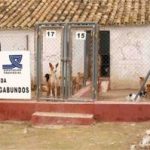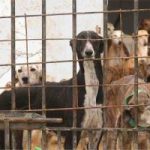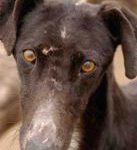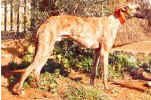‘Animales Vagabundos’ at Puerto Serrano, Villamartin, Cadiz, Spain 04/02/04
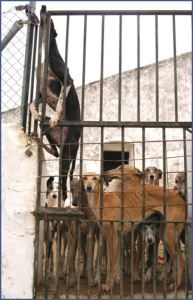
Please help us!!!!!
Pic by Marcella
Some readers may already be aware of the grave situation at this city council dog–pound where Juan Jesús Portillo (mmssinhogar@wanadoo.es) has an almost impossible task caring for hundreds of galgos in a small premises not designed as kennels. 500 galgos came through this refuge last year and many of us rescuing/homing groups took scores of them each, but not all were in the best of health nor even survived. At the moment, there are over 220 dogs of which approximately 100 are galgos mostly concentrated in one small area. Approx 175 galgos have been relocated by rescue groups in the last 2-3- months.
Cadiz, in Andalucia, is in the far south west of Spain, near Gibraltar and 840 miles (1400 km) away from Pep’s kennels north of Barcelona where we usually collect and prepare our dogs for export and homing abroad. This southern part of Spain is among the most underdeveloped in Spain and the internal rural areas lack just about everything except galgueros and gypsies.
Neither the local city council nor its vet are inclined to invest resources in helping Juan Jesús with what he needs to maintain sanitary conditions at the refuge, saying that the dogs are going to die anyway. Hence the spread of disease, pregnancies, parasites, gastro-enteritis, distemper, parvovirus, untreated fractures, wounds from fights, add to the already overcrowded conditions there where the dogs are fed in the open, and the dominant dogs score over the weaker ones in the scramble for food. The premises lacks pens or kennels dividing the dogs, hence cross infection is rife and exerting any control has been a lost cause.
It is not surprising then that without the help and scope he needs to improve conditions there, Juan Jesús’ main aim has been so far to move away as many dogs as possible to other groups. Sadly some dogs suffered in the process, infecting others we already had in our kennels who were hitherto well, or becoming more ill themselves due to relocation. Hence, after several months of trying to relieve the situation by taking dogs away, we are mostly now looking at how we can help them at source.
In doing this work in Spain for 13 years, I have always been caught by the unexpected, this time by help being offered from a source I would not have dreamed of. To my delight, I was contacted by Halie Hovenga, an American lady at the Naval base at Rota, near Cadiz who for while had been concerned too about the perrera and had taken in a pregnant bitch and her pups from there. After many mails to and fro, she managed to rally some help from two vets, i) an American, Dr. Kelly Rada and ii) a Spanish vet, Dr. Alejondra Gomez Ruiz-Henestrosa, (known as Dr. Sandra) and iii) Paul Carrier of Alpha Dog Kennels, who is a dog behaviourist. They went along to view the situation and to talk to Juan Jesús and to discuss the best course of action. High on the list of priorities are vaccination against distemper, leptospirosis, hepatitis, kennel cough, etc. These dogs are rarely vaccinated by the galgueros as pups as they use them usually only for one season, Sept –Jan, and then discard them, using new pups the following year. Next on the list is testing equipment for tick and mosquito borne diseases such as Ehrlichia, Borellia, Filariae and Leishmania, and then treatment for internal and external parasites. For this, the introduction of dividers and collar/colour identification are essential. Sadly it is inevitable that some clinically sick dogs will need to be euthanased to be able to save the lives of others…….. Our objectives are to identify , treat and protect the dogs who are healthy and eventually move them north nearer towards homing programmes in Belgium, Holland, France, Germany and UK. On January 24th a team of volunteers made their first working visit , vaccinating 40 dogs. We are all extremely grateful to Dr. Sandra for providing the vaccines at cost…….
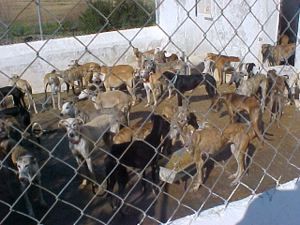
97 galgos are in 60 sq m when this pic was taken.
(Pic by Juan Jesús)
Practical help we have been able to offer so far in 2004:
- 450 tubes despatched of Flea Halt sent to GIN for distribution by David Wolf of the National Greyhound Adoption Programme, PA USA
- 100s of PVC coloured collars to help with identity control created and sent by GIN supporter Sharon Raby of Time is Tight UK
- Box of coats sent from GIN Uk for the skinny dogs
- 600 euros delivered by GIN/GRB (Greyhounds Rescue Belgium) to buy vaccine/testing equipment.
- £500 more granted by the GIN committee for taking up 4 discounted places at Alpha Kennels to rehabilitate four dogs.
- Some antibiotics and other meds delivered there by Marcella from Suzanne Stack’s (Arizona, USA) box of goods sent to GRB
- Jane Garcia, a GIN supporter, has taken in 8 galgos for rehabilitation at her own expense at her hacienda.
- Marcella &Jen of GRB flew to Cadiz 30/31st January to collect 4 galgos for homing in Holland & Belgium
We are not the only group helping at Cadiz. Others are:
-
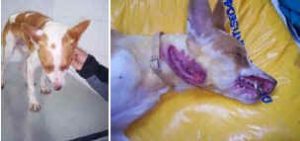
Sick galgo
(pic by Marcella)Paws Across the Pond twin-GPA Orlando Florida USA,
- Greyhounds Rescue Belgium
- The American European Greyhound Alliance Boston USA,
- SOS Galgos Barcelona,
- PRO GALGO Barcelona (Mo Swatek, Garcia Santos),
- Scooby Association, Spain
- Pro Animale, Germany
Any donations or further offers of help would be much welcomed.
Anne Finch
*********************************************************************
Letter from Halie Hovenga:
Military Address: PSC 819 Box 36
FPO AE 09645
Within EU: calle Naranjos no 6
11520 Rota
Cadiz, Spain tel (** 34) 956 840328
haliehovenga@hotmail.com
To Whom It May Concern:

Halie with Berlin , the pup she looked after, who flew to GRB to be homed with Marcella and Jen. (pic by Marcella)
I write today to request your help for the galgos living at Animales Vagabundos–better known as the “Cadiz Kennels”. It is well known that our friend and employee there, Juan Jesus, is overburdened, underpaid, and desperately needs assistance to provide humane living conditions for the dogs held there while they wait to be rescued by various Spanish and international rescue groups. It is my hope that I may provide that very assistance with the joint help of local Spanish and American veterinarians and volunteers.
After visiting the Cadiz Kennels various times throughout 2003, and more recently assembling a team of volunteers and two veterinarians that examined and vaccinated 40 galgos, I have come to the conclusion that my team of volunteers can best help by utilizing the following plan. It is this plan that I hope you will support through donations of money, medical supplies and spreading the word about our cause.
It is our plan that a rotating team led by a veterinarian or otherwise qualified individual will visit the Cadiz Kennels weekly to perform the following tasks:
- Perform physical examinations; test blood for erlichia, leishmaniasis and heartworm. Vaccinate, worm, apply antiparasitics, and attach an ID collar to each dog before it is released into the general galgo population at the kennel. Plastic, color-coded ID collars will be marked with arrival date, vaccination and worming dates and other pertinent information. Only dogs testing negative of leishmaniasis and heartworm as well as showing no other symptoms of highly contagious diseases will be released into the main galgo holding area where they will wait to begin their journeys to rescue shelters within and beyond Spain.
- Separate dogs with minor illnesses and wounds to be treated.
- Recommend those dogs that test positive for leishmaniasis and heartworm as well as those with serious injuries or showing signs of other highly contagious and life threatening illnesses for euthanasia. These dogs will go into a quarantined space until euthanasia can be administered.
- Examine general population for obvious signs of illness and for females in heat, separating dogs as necessary.
- Worm and apply antiparasitics to general galgo population at proper intervals.
- Properly clean and sterilize all galgo spaces.
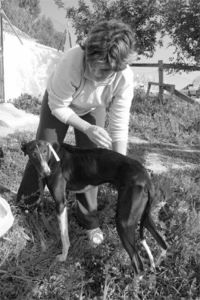
Spanish vet, Dr. Sandra, at the kennels
To properly execute this plan, we require four additional spaces beyond the main galgo holding area—one as a temporarily holding pen for newly arriving dogs awaiting examination, a second for those dogs in need of antibiotics or other treatment, a third for females in heat and a quarantine pen for those dogs awaiting euthanasia. I believe, Juan Jesus will grant us the needed space as the sick pen, pen for females in heat and euthanasia pen may be used for other breeds as well, maximizing available space. Some of these pens have already unofficially been designated. It is my hope that Juan Jesus learns from our plan, and begins to implement a similar plan for the other various breeds of dogs homed at the Cadiz Kennel.
Of course, I am open to suggestions, and think perhaps, there will be things I’ll learn from experience and from those wiser than myself as we go along. But, I think this is a good start, and I hope those reading this see it that way as well.
Again, I ask your support of our efforts here. We’re desperately in need of funds to cover much needed testing as dogs arrive at the kennel. By immediately testing and euthanizing those dogs with no chance of being fostered for the necessary long term and expensive treatments required, we limit the galgo population, and maximize resources.
The galgo population at the Cadiz Kennel is currently beyond healthy capacity so much so that stronger dogs guard food and even water, and employees there are unable to provide them proper attention. By tightening standards of those dogs admitted we will guarantee greater health to the galgo population as a whole. In addition, we will also protect the general population from the spreading of these diseases—saving hundreds of lives in the long run. All this can be achieved through immediate testing of galgos as they arrive at the kennel.
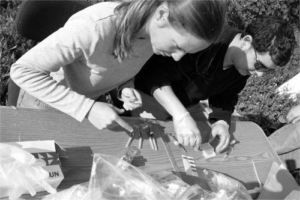
Volunteers hard at work: Sara Kassow from USA alongside Antonio Guerrero from Spain
(Pics by Tony Lee)
There has been some concern that it is not possible to test as we’ve planned. After some thought, our team has decided that it is possible through the use of very large coolers for refrigeration, tables for a flat surface needed during testing (and other tasks) and a team of volunteers to assist with drawing blood, preparing and awaiting test results. We are aware of the time commitment involved, and believe that once the main chore of testing the general galgo population is accomplished, our work will begin to pay off.
I thank you for your time and concern about the galgos in Spain. It is only through your help am I able to organize such a project and pull it off. We’ve received so many things to help us—antibiotics, medical supplies, antiparasitics, colored PVC dog collars and coats for skinnies; it’s all wonderful! Now, it’s time to begin, and all we need are IDEXX test kits. They are expensive; we know, but necessary. Please, if you can help by donating money towards kits, you’ll receive the satisfaction of knowing you helped save lives, because that’s exactly what we plan to do at the Cadiz Kennel—save lives.
Warmest Regards,
Halie Hovenga
February 3rd 2004
The weekend beginning 30th Jan 2004, Marcella and Jen of Greyhounds Rescue Belgium flew from Brussels to Faro to meet the people involved who are helping with the galgos of Cadiz. They were picked up by Jane Garcia, a Scottish supporter and her husband Fernando, who drove them 2.5 hrs first to their hacienda in Carmona where they look after 16 galgos and 66 horses! Next day sadly they could not meet up with Juan Jesús because he had had a car accident in the rain but they went with Halie to the refuge and took photos. It was a sad experience to see so many dogs without help and many of them sick.

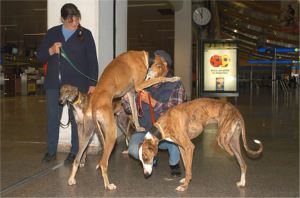
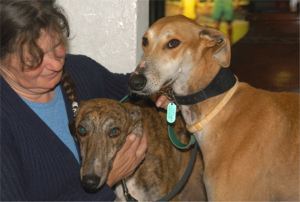
Some dogs are lucky, however. Here you see Puma, Lola and Kiko with three legs, taking farewell of Jane and Fernando at the airport. They had looked after them for some weeks having taken them in from the Cadiz refuge to rehabilitate them in preparation for travelling, with the pup Berlin of course, back to Belgium and Holland with Marcella and Jen to homes. Anne
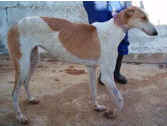 How you can Help
How you can Help
- Offer to pay bills for vaccine antiparasitics and disease-testing kits. (Altogether about 25 euros per dog)
- Offer vet/.nursing /kennel experience to join Halie’s Saturday team (all organising and travel/subsistence expenses, sorry, will be up to you, but you will be welcomed)
- Offer to pay the kennelling (5 euros per dog per day) and vet bills (preparing them for export and homing) of up to four galgos at Paul’s Alpha kennels in Cadiz.
- Offer a home to a galgo from Cadiz (if you are in mainland Europe)
- Offer to fund GRB’s (Greyhounds Rescue Belgium) air flights (approx 190 euros) to Faro where Virgin lets them take 5 dogs back free of charge
- Contact us for information

